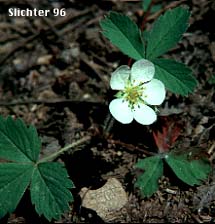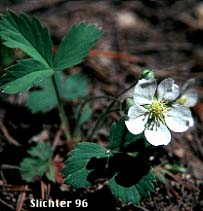Woods strawberry is a deciduous perennial which is strongly stoloniferous. The stolons arch through the air and form "baby" plants where they come in contact with the ground. The leaves are long petiolate (5-10 cm) with 3 leaflets. The leaflets are thin to fairly thick in cross-section and are broadly elliptic to obovate-oblong in shape. The leaflets are yellow-green in color with prominent venation and the blade surface bulged between veins. The leaflet margins are coarsely toothed.
The inflorescence is a 3-11 flowered cyme with showy white (occasionally pink-tinged) flowers which usually exceeds the height of the leaves. The 5 petals are 8-11 mm long and surround a central cluster of yellow stamens. The fruit is globose, red, and very sweet, and is up to 1 cm wide.Strawberries get their common name from the practice of placing straw about the plants to keep the fruit from touching the ground and spoiling. The fruits are highly prized, and may be eaten raw or cooked in cobblers or jams. A tea made of the leaves is high in Vitamin C. Various small animals eat the berries.
It is found in meadows, light woods, and along streambanks. It is most common through the earliest stages of successional growth.
Woods strawberry was evidently introduced to North America from Europe during the 1700s. It is now widespread over much of North America. Variety bracteata may now be found from British Columbia south to California along the east side of the Cascades. It may also be found in the Puget Trough and in the Willamette Valley. It is found eastward to Alberta and hence south in the Rockies through Montana and Wyoming to New Mexico.
Woods strawberry blooming along the Holland Falls National Recreation Trail #416, Flathead National Forest......May 27, 2023.
 -
- 